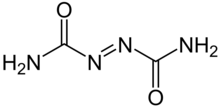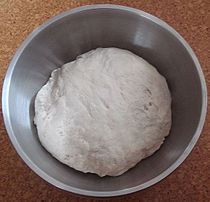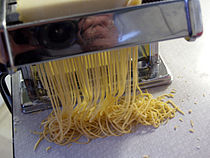Dough


Dough (ⓘ) is a thick, malleable, sometimes elastic, paste made out of any grains, leguminous or chestnut crops. Dough is typically made by mixing flour with a small amount of water and/or other liquid, and sometimes includes yeast or other leavening agents as well as other ingredients such as various fats or flavorings.
The process of making and shaping dough is a precursor to making a wide variety of foodstuffs, particularly breads and bread-based items, but also including biscuits, cakes, cookies, dumplings, flatbreads, noodles, pasta, pastry, pizza, piecrusts, and similar items. Doughs are made from a wide variety of flours, commonly wheat but also flours made from maize, rice, rye, legumes, almonds, and other cereals and crops used around the world.
Types of dough


Doughs vary widely depending on ingredients, the kind of product being produced, the type of leavening agent (particularly whether the dough is based on yeast or not), how the dough is mixed (whether quickly mixed or kneaded and left to rise), and cooking or baking technique. There is no formal definition of what makes dough, though most doughs have viscoelastic properties.[1]
Leavened or fermented doughs (generally made from grain cereals or legumes that are ground to produce flour, mixed with water and yeast) are used all over the world to make various breads. Salt, oils or fats, sugars or honey and sometimes milk or eggs are also common ingredients in bread dough. Commercial bread doughs may also include dough conditioners, a class of ingredients that aid in dough consistency and final product.
Flatbreads such as pita, lafa, lavash, matzah or matzo, naan, roti, sangak, tortilla, and yufka are eaten around the world and are also made from dough. Some flatbreads, such as naan, use leavening agents; others, such as matzo, do not. Crackers are also made from dough, and some (such as saltine crackers[2]) are leavened.
Pasta and noodles are generally based on unleavened doughs that are worked until they are dry and smooth, and then shaped into their final form. The finished pasta may be cooked immediately or dried before cooking.
Doughs with higher fat content have a lesser water content, develop less gluten and are therefore generally less elastic than bread doughs; these doughs are often called "short" by bakers. This category includes many cookie and pie crust doughs, such as shortcrust pastry.[1]
In many parts of central India, people use the quick method of making an instant roasted dough ball or baati. In countries in the Sahel region of Africa, dough balls called aiysh or biya are made from sorghum or millet, and are ground and boiled.[citation needed]
Quick breads use leavening agents other than yeast (such as baking powder or baking soda), and include most cookies, cakes, biscuits, and more; these may be based on a batter or a dough.
Techniques
Techniques used in dough production depend on the type of dough and final product.
For yeast-based and sponge (such as sourdough) breads, a common production technique is the dough is mixed, kneaded, and then left to rise. Many bread doughs call for a second stage, where the dough is kneaded again, shaped into the final form, and left to rise a final time (or proofed) before baking.[3] Kneading is the process of working a dough to produce a smooth, elastic dough by developing gluten.[3] This process is both temperature and time-dependent; temperatures that are either too hot or too cold will cause the yeast to not develop, and rising times that are either too short or too long will affect the final product.[citation needed]
Pasta is typically made from a dry dough that is kneaded and shaped, either through extrusion, rolling out in a pasta machine, or stretched or shaped by hand (as for gnocchi or dumplings). Pasta may be cooked directly after production (so-called "fresh pasta") or dried, which renders it shelf-stable.
Doughs for biscuits and many flatbreads which are not leavened with yeast are typically mixed but not kneaded or left to rise; these doughs are shaped and cooked directly after mixing.
While breads and other products made from doughs are often baked, some types of dough-based foods are cooked over direct heat, such as tortillas, which are cooked directly on a griddle. Fried dough foods are also common in many cultures.
Pancakes, waffles, some kinds of bar cookies such as brownies, and many cakes and quick breads (including muffins and the like) are often made with a semi-liquid batter of flour and liquid that is poured into the final shape, rather than a solid dough. Unlike bread dough, these batters are not stabilized by the formation of a gluten network.[4]
-
Dough being kneaded
-
Yeast bread dough after kneading, before rising
-
Yeast bread dough after rising (proofing), for 40 minutes
-
Dough being extruded from a pasta machine
Dough additives (Canada)

Acetone peroxide is an oxidizing agent used to mature and strengthen flour. This product speeds up the oxidation process which allows companies to produce baked goods faster and more efficiently. As with other dough additives, acetone peroxide has a multitude of purposes outside of Canadian dough making, one of which is it has been used by terrorists to make explosives.[6]
Ammonium persulfate is used in baking, which acts to improve baking quality and color of flour. This additive supplies nitrogen for the yeast which improves consistency, volume and shelf life. It also serves to control the pH of flour and baked products.[7]
Ascorbic acid, otherwise known as vitamin C, is used as an antioxidant in dough. By controlling the amount of oxygen reacting with the bread products, it acts to promote optimal taste and texture. It is also used as an ingredient preservative in baked goods, as it increases the shelf life by controlling oxidation[8]. This additive can also boost a product’s vitamin content, and when used in bread, it enhances the elasticity and size of the loaf when baked.[9]
Azodicarbonamide is used as a bleaching agent in flour and helps the dough rise through its conditioning properties.[10]There is however public concern over the use of azodicarbonamide being used in yoga mats and other plastic foams, as it has been associated with respiratory problems. [11] A Canadian expert argues that respiratory problems associated with azodicarbonamide are associated with workers in industrial plants who inhale the chemical, which is the reason some countries have banned this additive.[12]

Benzoyl peroxide is used as a bleaching agent in white and whole wheat flour within specific quantities.[14] No major health concerns have been found with benzoyl peroxide use in regulated quantities.[15]
Calcium iodate is a food additive used to condition dough by reducing the amount of yeast required to raise dough[16]. In Canada, it is found in unstandardized bakery products and bread, at trace quantities.[17]
Calcium peroxide is a food additive that helps to whiten flour due to the bleaching powers of peroxide.[18] The improved texture is achieved by strengthening the gluten wall. Further, it is often applied in oral products such as toothpaste as a whitening agent. However, its effectiveness is doubted.[19]

Calcium stearoyl-2-lactylate is a food additive that is found in many food products, such as baked goods, desserts, powdered drink mixes, dehydrated potatoes, and chewing gums.[21] In Canada, it is commonly used in yeast-leavened recipes as an emulsifier during bread making. In bread, calcium stearoyl-2-lactylate helps to improve the mixability of the dough and strengthen it. It also improves bread’s grain and texture, as well as the volume of the final loaf.[22]
Chlorine is a food additive that bleaches flour products. In cake production, the application of chlorinated flour helps to improve the structure-forming capacity. Chlorinated flour is also used in biscuit production to keep the raw dough firm and easier to handle.[23] It is worth to note that in some European countries such as Germany, Switzerland, and Belgium, chlorine is banned as a washing agent. Therefore, new alternatives may be required and are being researched currently.[24]

Chlorine dioxide is a water soluble chemical compound used as predominantly used in bleach[26]. Bleaching agents make the flour appear whiter, as well as oxidize the surfaces of the flour grains to help with the development of gluten[27]. Chlorine Dioxide can also be used as a dough conditioner which can help make the dough firm and decrease mixing time. Using Chlorine Dioxide in baking can improve the texture, size and surface smoothness of bakery goods.
L-cysteine hydrochloride is a non-essential amino acid formed by the body and is used in the baking industry as a dough conditioner. This chemical compound breaks the bonds of gluten to lower the viscosity, which enhances the dough rising process during baking. This additive also helps to keep the doughs shape by preventing shrinkage during freezing[28]. L-cysteine is a non-essential amino acid that the human body can obtain by converting the essential amino acid methionine. It is commonly sold as a dough conditioner in the form of L-cysteine hydrochloride. In bread, flour and whole wheat flour, 90 p.p.m. of L-cysteine hydrochloride is allowed for using in Canada. In unstandardized bakery products, Good Manufacturing Practice is followed. In baking, L-cysteine hydrochloride acts by disrupting the gluten disulfide bonds, which reduces the viscosity of the dough and therefore makes it easier to work the dough and helps the dough to rise while giving it more elasticity. In addition, L-cysteine keeps dough shape and prevents shrinkage during dough freezing.
Potassium iodate is synthesized from potassium hydroxide and iodine and acts as a fast-acting oxidant used to fully develop the dough. Using this additive in dough strengthens the structure and enhances the elasticity which in turn, enhances the overall quality and texture of the baked goods[29]. Potassium iodate is an oxidant that functions quickly when it is entirely consumed in dough mixing. It enhances the dough’s fermentation, elasticity and stability. It also assists in dough preparation by improving the volume and the texture of the bakery products. It strengthens the formation of disulphide bonds in gluten of the dough. The gluten network in the dough is then strengthened. In Canada 45 p.p.m. of Potasium Iodate is permitted to be used in bread and in unstandardized bakery products.
Potassium persulfate is used to strengthen and condition dough by promoting gluten formation[30]. In Canada, it is classified as a food additive in bread making according to particular requirements[31].

Sodium stearoyl-2-lactylate (SSL) is an approved food additive for commercial production of dough in Canada[33]. SSL acts as an emulsifier in bread making and reduces the rate of staling in crumb during storage time. It can improve dough strength by forming bonds with proteins in flour during gluten development[34].

Sodium stearyl fumarate is a form of fumaric acid, acting as a dough conditioner, oxidant and wheat flour treatment agent in yeast-fermented products [36]. In Canada, SSF is permitted to use in bread or other unstandardized bakery products within a certain amount of flour[37].
Sodium sulfite is a food preservative that controls harmful growth of microorganisms. In Canada, it acts as a preservative in biscuit dough[38]. Sulphites in general are considered a priority allergen due to the allergic symptoms sensitive individuals have[39]. Other sources of sulphites can come from alcohol, dressings, condiments and many other common grocery items[40]. Regarding the amounts of sulfites found in buscuit dough, the Canadian government has regulated how much is permitted in dough products.[41]
As a term
The word "dough" is a common slang term for money in English-speaking countries; this usage is originally American, and dates to the mid-19th century.[42]
See also
- Baking
- Dough blender
- Dough scraper
- Farinograph – a tool that measures specific properties of flour
- List of breads
- List of pasta
- List of fried dough foods
- List of pastries
- Proofing (baking technique)
- Parchment paper
- Roller docker
- Royal icing
- Straight dough
- Stuffing
References
- ^ a b Leon Levine; Ed Boehmer (1997). "Chapter 12, Dough Processing Systems". Handbook of Food Engineering Process. doi:10.1201/9781420049077.ch12.
- ^ Ponte, J. G.; Payne, J. D.; Updated By Staff (2007). "Bakery Processes, Yeast-Raised Products". Kirk-Othmer Encyclopedia of Chemical Technology. doi:10.1002/0471238961.2505011916151420.a01.pub2. ISBN 0471238961.
- ^ a b Irma S. Rombauer; Marion Rombauer Becker; Ethan Becker (1997). Joy of Cooking. Scribner. pp. 738–742. ISBN 0684818701.
- ^ Stanley P. Cauvain. (2012) Chapter 12: Baking. in Food Processing Handbook. 2 ed. Wiley. p. 422 ISBN 9783527324682. This reference is specifically about cake batter.
- ^ "Acetone peroxide | C9H18O6 | ChemSpider". www.chemspider.com. Retrieved 2017-08-01.
- ^ "Acetone Peroxide Added to Food?". Food - Construed. 2011-08-25. Retrieved 2017-07-28.
- ^ Noshly. "Wise Eating, Made Easy". Noshly. Retrieved 2017-07-28.
- ^ Bruso, Jessica. "How Is Ascorbic Acid Used in Food?". LIVESTRONG.COM. Retrieved 2017-07-28.
- ^ "Ascorbic Acid and its Use in Food". The Spruce. Retrieved 2017-07-28.
- ^ WEEKS, CARLY (2014-02-18). "Are chemical additives always a bad thing?". Retrieved 2017-07-28.
- ^ WEEKS, CARLY (2014-02-18). "Are chemical additives always a bad thing?". Retrieved 2017-07-28.
- ^ WEEKS, CARLY (2014-02-18). "Are chemical additives always a bad thing?". Retrieved 2017-07-28.
- ^ "Acetone peroxide | C9H18O6 | ChemSpider". www.chemspider.com. Retrieved 2017-08-01.
- ^ Canada, Health. "2. List of Permitted Bleaching, Maturing or Dough Conditioning Agents (Lists of Permitted Food Additives) - Canada.ca". www.canada.ca. Retrieved 2017-07-28.
- ^ El-Samragy, Yehia. "Benzoyl Peroxide" (PDF).
{{cite web}}: Cite has empty unknown parameter:|dead-url=(help) - ^ "Dough conditioner". Wikipedia. 2017-02-26.
- ^ Canada, Health. "2. List of Permitted Bleaching, Maturing or Dough Conditioning Agents (Lists of Permitted Food Additives) - Canada.ca". www.canada.ca. Retrieved 2017-08-01.
- ^ Blix.co. "Food Grade Calcium Peroxide". PeroxyChem. Retrieved 2017-07-28.
- ^ "» Can toothpastes really whiten teeth? Office for Science and Society". blogs.mcgill.ca. Retrieved 2017-07-28.
- ^ "Acetone peroxide | C9H18O6 | ChemSpider". www.chemspider.com. Retrieved 2017-08-01.
- ^ "Calcium stearoyl-2-lactylate". Wikipedia. 2017-04-11.
- ^ "Calcium Stearoyl Lactylate (CSL) | Baking Ingredients | BAKERpedia". bakerpedia.com. Retrieved 2017-07-28.
- ^ "Flour bleaching agent". Wikipedia. 2016-09-03.
- ^ "A boost for efficient, safe food production - Horizon 2020 - European Commission". Horizon 2020. Retrieved 2017-07-28.
- ^ Edgar181 (2008-03-12), chemical structure of sodium sulfite (sulphite), retrieved 2017-08-01
{{citation}}: CS1 maint: numeric names: authors list (link) - ^ "Chlorine dioxide". Wikipedia. 2017-06-06.
- ^ "Flour bleaching agent". Wikipedia. 2016-09-03.
- ^ "L-Cysteine Hydrochloride Uses, Benefits and Side Effects". Nootriment - Health Supplement Reviews and Research. 2015-02-08. Retrieved 2017-08-01.
- ^ "Potassium Iodate | Baking Ingredients | BAKERpedia". bakerpedia.com. Retrieved 2017-08-01.
- ^ "Oxidizing Agents | Baking Ingredients | BAKERpedia". bakerpedia.com. Retrieved 2017-08-01.
- ^ Canada, Health. "2. List of Permitted Bleaching, Maturing or Dough Conditioning Agents (Lists of Permitted Food Additives) - Canada.ca". www.canada.ca. Retrieved 2017-08-01.
- ^ Edgar181 (2008-03-12), chemical structure of sodium sulfite (sulphite), retrieved 2017-08-01
{{citation}}: CS1 maint: numeric names: authors list (link) - ^ "Sodium stearoyl lactylate". Wikipedia. 2017-07-01.
- ^ "Sodium Stearoyl Lactylate (SSL) | Baking Ingredients | BAKERpedia". bakerpedia.com. Retrieved 2017-08-01.
- ^ Edgar181 (2008-03-12), chemical structure of sodium sulfite (sulphite), retrieved 2017-08-01
{{citation}}: CS1 maint: numeric names: authors list (link) - ^ "Sodium Stearyl Fumarate Market - Global Industry Analysis, Size, Share, Growth, Trends, and Forecast 2017 - 2027". www.transparencymarketresearch.com. Retrieved 2017-08-01.
- ^ Canada, Health. "2. List of Permitted Bleaching, Maturing or Dough Conditioning Agents (Lists of Permitted Food Additives) - Canada.ca". www.canada.ca. Retrieved 2017-08-01.
- ^ "Sulphites - Food Allergy Canada". Food Allergy Canada. Retrieved 2017-08-01.
- ^ "Food Allergens - Food Allergy Canada". Food Allergy Canada. Retrieved 2017-08-11.
- ^ Canada, Health. "Sulphites - Priority allergens - Canada.ca". www.canada.ca. Retrieved 2017-08-01.
- ^ Canada, Health. "2. List of Permitted Bleaching, Maturing or Dough Conditioning Agents (Lists of Permitted Food Additives) - Canada.ca". www.canada.ca. Retrieved 2017-08-11.
- ^ "dough". Oxford English Dictionary (Online ed.). Oxford University Press. (Subscription or participating institution membership required.)
Further reading
- Cuvain, Stanley; Linda S. Young (2007). Technology of Breadmaking (2 ed.). Springer. doi:10.1007/0-387-38565-7. ISBN 9780387385655.—covers commercial dough production
- DiMuzio, Daniel (2009). Bread Baking: An Artisan's Perspective. Wiley. ISBN 978-0470138823.—covers home and commercial baking and dough techniques
- Hamelman, Jeffrey (2004). Bread: A Baker's Book of Techniques and Recipes. Wiley. ISBN 978-0471168577.—covers home and commercial baking and dough techniques





